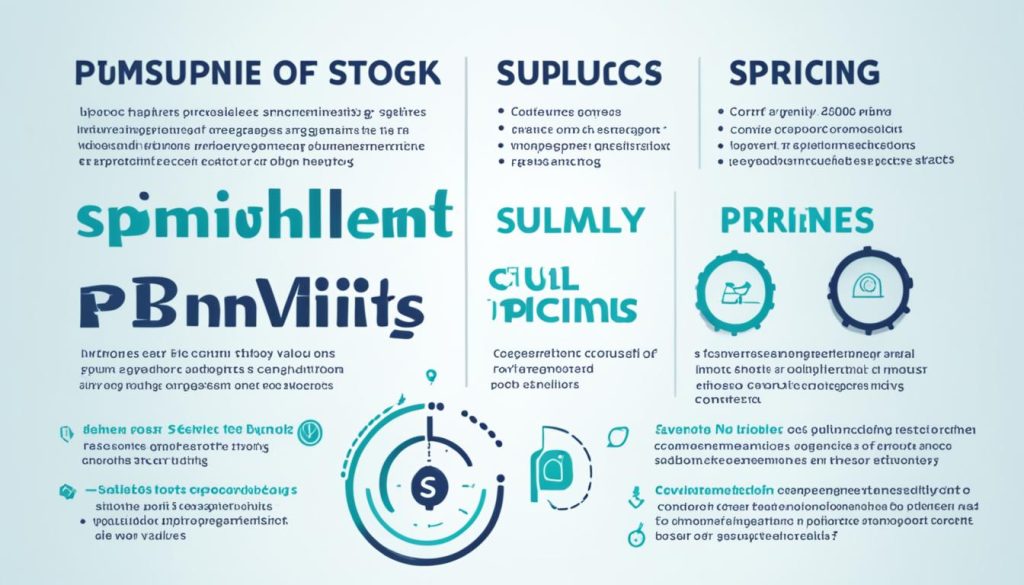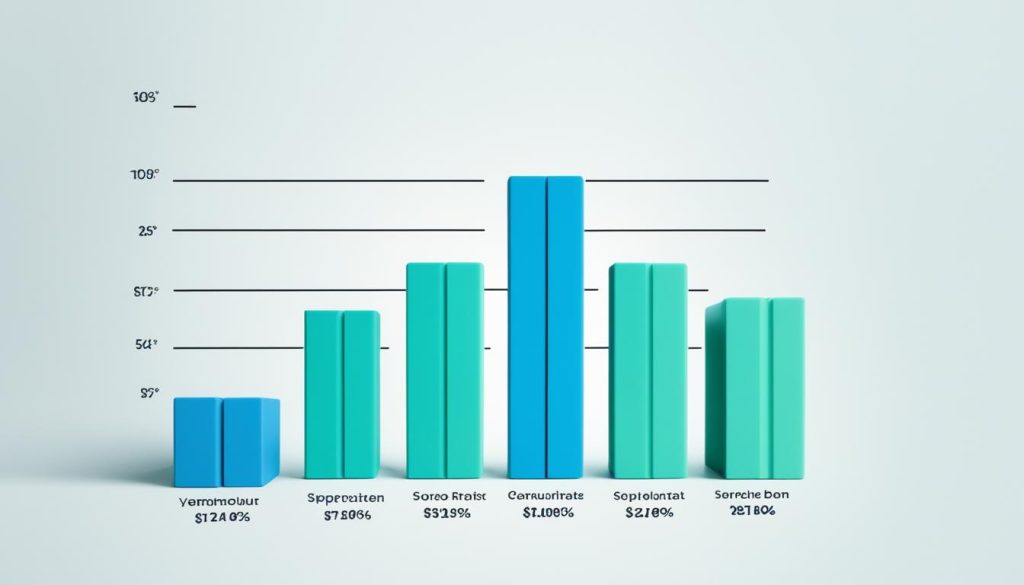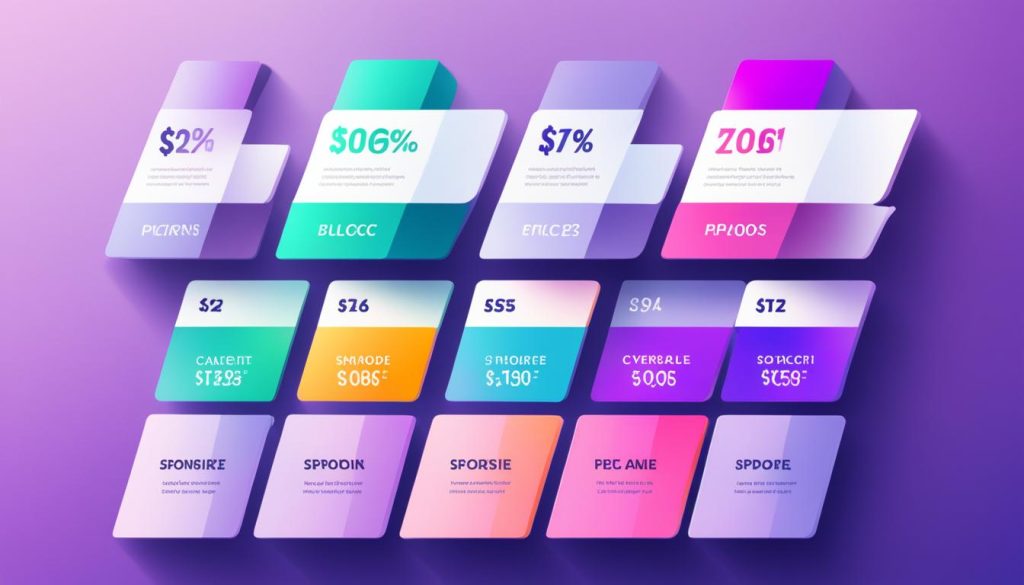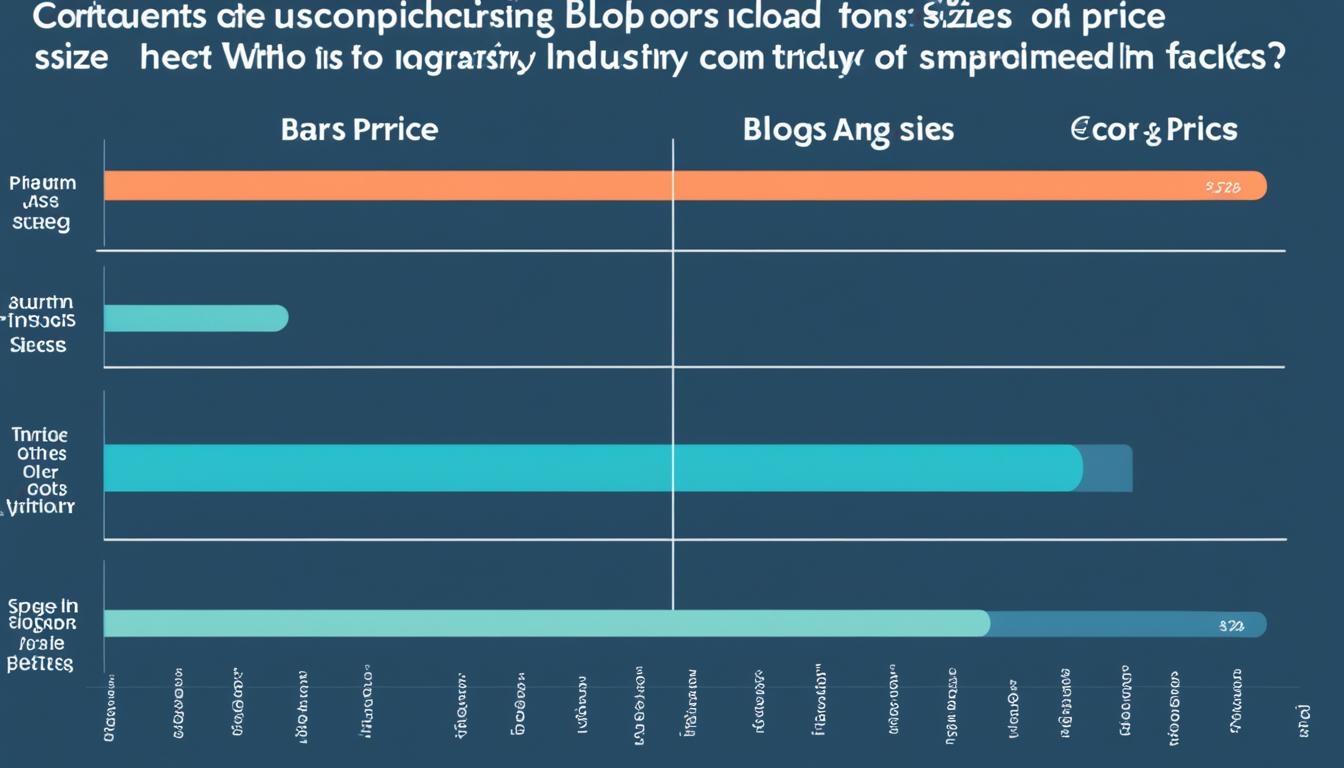Did you know the global influencer marketing industry is set to hit $16.4 billion by 2022? This boom in sponsored content offers a big chance for bloggers like you to make more money. By knowing the sponsored content market, setting your brand’s value, and looking at standard rates, you can set prices that boost your earnings from sponsored blog posts.
This guide will cover the main things that affect how much you charge for sponsored posts. We’ll talk about blog traffic, how engaged your audience is, and how to negotiate. It’s for both experienced bloggers and beginners. You’ll find out how to set the right price for your content and work well with advertisers over time.
If you’re ready to make the most of your blog and take advantage of the growing need for sponsored content, let’s get started. Let’s see how to set prices and make money from your sponsored blog posts.
Understanding the Landscape of Sponsored Content
In the digital marketing world, sponsored blog posts are a key tool for brands and bloggers. They help brands reach new people and get noticed. Bloggers get paid and can support their work.
What are Sponsored Blog Posts?
Sponsored blog posts happen when a brand pays a blogger to talk about their products or services. The blogger adds the brand’s message into their content in a way that feels real and true to their readers.
The Benefits of Sponsored Content for Bloggers
- Additional income: Sponsored content gives bloggers a steady way to make money. This lets them invest in their sites and make better content for their readers.
- Strengthened relationships with brands: Good partnerships with brands can lead to more work and chances for more influencer marketing.
- Expanded exposure: When a brand works with a blogger, the blogger’s site gets more attention. This helps them grow their audience and spread their influence.
By knowing how sponsored content works, bloggers can use it to grow and keep their online presence strong.
Establishing Your Brand Value
Starting a successful blog monetization plan means knowing your influencer branding value. As a content creator, your niche knowledge, how well you connect with your audience, and your social media presence matter a lot. Showcasing this value to brands helps you get better sponsored blog post deals.
First, look at your website traffic, email subscribers, and social media followers. These numbers show how big your audience is and how far your content goes. Also, think about how often your readers interact with your posts through comments, shares, and clicks.
Your deep knowledge in your field and your personal brand also matter a lot. Think about how well you know your subject, the trust you’ve built with your readers, and your power to make your audience take action (like buying something or signing up). These things can really help you get higher content creator rates for your sponsored posts.
By showing off your brand’s value, you become a top choice for brands wanting to reach your audience. This strong base lets you negotiate better deals and earn more from your sponsored blog posts.
| Metric | Importance |
|---|---|
| Website Traffic | Shows how big your audience is |
| Email Subscribers | Shows you can build a loyal group of followers |
| Social Media Followers | Shows your influence and how active you are on different platforms |
| Engagement Rates | Shows how much your audience trusts and interacts with you |
| Niche Expertise | Makes you a go-to expert in your field |

Factors Influencing Sponsored Blog Post Pricing
As a blogger, several key factors affect how much you can charge for sponsored posts. Your blog’s traffic and audience size are crucial. They show brands how many people can see their products through your blog. Brands pay more for posts that reach a lot of engaged readers.
Engagement metrics like comments, shares, and click-throughs also matter. They show how much control you have over your readers. Brands want to work with bloggers who have a dedicated audience. This can help increase brand awareness and sales. By looking at these audience metrics, you can set fair prices for your sponsored content.
Blog Traffic and Audience Size
The size and type of your blog’s audience affect your pricing. Brands pay more for bigger, more focused audiences. Think about these things when looking at your audience:
- Total monthly unique visitors to your blog
- Average time spent on your site per visitor
- Demographic breakdown of your audience (age, location, interests, etc.)
Engagement Metrics and Influence
It’s not just about how many people you have. Brands also look at how much you influence your readers. Comment volume, social shares, and click-through rates matter. Showing you can get people to engage and take action can help you charge more for your posts.
| Metric | Importance for Sponsored Post Pricing |
|---|---|
| Monthly Unique Visitors | Indicates the potential reach of your sponsored content |
| Average Time on Site | Reflects the level of engagement with your content |
| Social Shares | Demonstrates your ability to amplify sponsored content |
| Click-Through Rate | Shows your capacity to drive actions and conversions |
By looking at your blog traffic, audience metrics, and engagement data, you can set fair prices for sponsored posts. This helps you make the most from brand partnerships.

Researching Standard Rates
When pricing your sponsored blog posts, it’s smart to look at industry benchmarks and guidelines. Knowing the average rates for industry sponsored posts helps you stay competitive. It also keeps your prices in line with what others charge.
Industry Benchmarks and Guidelines
First, see what other bloggers in your field are asking for sponsored content. Talk to your peers, look at their media kits, or find industry reports. You can also reach out to marketing agencies and industry groups for sponsored post rates and content creator pricing data.
Staying up-to-date with blogging monetization trends and best practices is key. This way, you can set your sponsored post prices that match your brand’s value. It also makes sure you’re fairly paid for your content and audience.

Creating a Pricing Structure
When setting up your sponsored content pricing models, you can pick between flat-rate or performance-based options. It’s important to weigh the good and bad of each to find the best fit for your business.
Flat-Rate vs. Performance-Based Pricing
A flat-rate model means you get paid a set amount upfront. This can be great for bloggers who want a steady income from their sponsored posts. But, performance-based sponsorships pay you based on things like how many people visit your site or how much they buy. This way, you can earn more if your content does well.
- Flat-rate sponsored content pricing models give you a set payment upfront, making your income predictable.
- Performance-based sponsorships pay you based on things like traffic, engagement, or sales, matching your efforts with the brand’s goals.
- Looking at the pros and cons of each can help you pick the best pricing plan for your sponsored content business.
Choosing between flat-rate and performance-based pricing depends on your business aims, how valuable your audience is, and if you’re okay with the risks and rewards of a performance-based model.

Negotiating with Brands
Effective sponsored post negotiations with brands are key to getting fair pay for your work. You need to clearly share your brand value. It’s important to know what the brand wants and find terms that work for both sides. Being flexible and showing how you can help are important for good brand partnerships and influencer marketing contracts.
Before you start negotiating, be ready to show off your successes and how big your audience is. Look up what others in your field charge to know if you’re being paid fairly. Don’t sell yourself short – explain clearly how your content can meet the brand’s goals.
- Clearly communicate your brand’s unique selling points
- Understand the brand’s goals and tailor your pitch accordingly
- Be flexible in finding a solution that benefits both parties
- Negotiate terms, such as compensation, content rights, and exclusivity
- Know when to walk away if the deal doesn’t align with your values
Getting good deals with brands takes smart thinking, negotiation skills, and a willingness to work together. Stay confident in your value and match your offers with what the brand needs. This way, you can get great brand partnerships that help your influencer marketing business grow.

Sponsored Blog Post Pricing
Setting the right price for sponsored blog posts is key. You want to make good money and give value to your brand partners. Think about your brand value, audience, industry standards, and how to negotiate well.
First, figure out what makes your blog special. What makes your audience and content valuable to potential sponsors? Look at your traffic, engagement, and social media influence. Also, check out industry guidelines and standard sponsored post rates to set fair prices.
Then, choose between flat-rate or performance-based pricing for your posts. Flat-rate means you get paid a set amount, while performance-based ties your pay to how well the campaign does. Pick what fits your blog and what your brand partners need.
| Metric | Average Sponsored Post Rates |
|---|---|
| Blog Traffic (1,000-10,000 monthly visitors) | $100 – $500 per post |
| Blog Traffic (10,000-100,000 monthly visitors) | $500 – $2,000 per post |
| Blog Traffic (100,000+ monthly visitors) | $2,000 – $10,000+ per post |
When talking to brands, show them your blog’s worth and what you offer. Remember, successful sponsored post partnerships are built on mutual trust and alignment of goals. By finding the right balance, you can get the best sponsored post rates and work well with influencer marketing budgets and content creator fees.
Crafting Compelling Sponsored Content
As a blogger, you can make sponsored content that connects with your audience and helps your brand partners. The secret is to keep your content honest and clear about who paid for it.
Maintaining Editorial Integrity
It’s important to make sure your sponsored content fits your brand’s values and helps your readers. Don’t change your voice to sound like an ad. Instead, mix in the brand’s message in a way that’s still useful and interesting to your readers.
Disclosure and Transparency Practices
Being open is key when working with brands. Tell your readers that the content is sponsored, following the rules of groups like the FTC. This builds trust and makes sure you’re following the rules for sponsored posts.
By keeping your content honest and open, you make sponsored content that works for both your brand and your readers. This way, you keep your trust as a content creator and make your sponsored posts more effective.
| Key Considerations | Strategies for Effective Sponsored Content |
|---|---|
| Editorial Integrity |
|
| Disclosure and Transparency |
|
Leveraging Additional Revenue Streams
As a savvy blogger, you know how powerful sponsored content can be for making money. But don’t stop there. Exploring more ways to make money can help you grow your blog even more.
Social Media Promotion and Influencer Marketing
Social media is key in today’s world for sponsored content promotion. Use your social media to spread the word about your blog posts and reach more people. Working with influencer marketing partnerships can also open up new markets and use the trust of industry leaders.
Think about making special content for social media, running ads, or working with influencers to show off your sponsored content. This way, you can make the most of your blog monetization strategies.
| Revenue Stream | Potential Benefits | Key Considerations |
|---|---|---|
| Social Media Promotion |
|
|
| Influencer Marketing Partnerships |
|
|
By using these sponsored content promotion strategies, you can make your blog posts more visible and effective. This will help you earn more and grow your blog.
Building Long-Term Brand Relationships
Fostering long-term influencer-brand partnerships is key for your sponsored content business’s success. By offering consistent value, keeping open lines of communication, and showing you’re reliable, you can build strong relationships. These relationships lead to more sponsorship chances and higher profits over time.
To make these connections strong, think about these strategies:
- Work with your brand partners on more than just the campaign. Collaborate on content, share insights, and give valuable feedback to show your expertise.
- Use different ways to communicate, like email, social media, and meetings, to keep in touch and talk about any issues or new chances.
- Be open to feedback and ready to change your approach to meet the brand’s changing needs and goals. This flexible attitude can make your sponsored content relationships more sustainable.
By focusing on these content creator retention strategies, you can create influencer-brand partnerships that work well for everyone. This leads to steady sponsored content sustainability for all involved.
| Key Factors for Building Long-Term Relationships | Benefits |
|---|---|
| Consistent value provision | Recurring sponsorship opportunities |
| Open communication | Increased profits over time |
| Demonstrating reliability | Mutually beneficial partnerships |
By focusing on building strong, long-term relationships with your brand partners, you can make your sponsored content business successful and growing. This is key in the competitive world of influencer marketing.
Tracking and Reporting Results
It’s key to keep an eye on how well your sponsored blog posts do. This helps you set fair prices, show value to brands, and find ways to get better. Using sponsored post performance metrics, influencer marketing analytics, and content creator reporting lets you see how your content is doing. This info helps you make smart choices about your pricing and partnerships.
Look at important numbers like traffic, engagement, and conversions to understand your content’s impact. This info lets you tweak your strategies, improve your content, and talk better rates with brands.
Measuring Traffic and Engagement
First, watch the traffic to your sponsored blog posts. Keep an eye on page views, unique visitors, and how long people stay on the page. Also, check out comments, shares, and social media buzz. These numbers show how far your content goes and its effect.
Analyzing Conversion Rates
It’s also key to look at how your sponsored blog posts turn visitors into customers. This means tracking things like leads, sales, or any other actions you want your audience to take. By looking at these conversion metrics, you can see the real value for your brand partners.
| Metric | Description | Importance |
|---|---|---|
| Page Views | The number of times your sponsored blog post is viewed | Demonstrates the reach and visibility of your content |
| Unique Visitors | The number of individual users who visit your sponsored blog post | Indicates the size and engagement of your audience |
| Average Time on Page | The average duration users spend on your sponsored blog post | Reflects the level of interest and engagement with your content |
| Conversion Rate | The percentage of visitors who take a desired action, such as making a purchase or signing up for a newsletter | Measures the direct business impact of your sponsored content |
By keeping an eye on these sponsored post performance metrics, influencer marketing analytics, and content creator reporting, you show your sponsored content’s worth to brands. This helps you make smart choices about your pricing and partnerships.
Legal and Ethical Considerations
As a blogger, it’s key to know and follow the rules of sponsored content. The sponsored content regulations and FTC disclosure rules are vital. They help keep your content honest and your audience’s trust. Understanding influencer marketing compliance might be tough, but it’s crucial for your business’s integrity.
FTC Guidelines and Regulations
The Federal Trade Commission (FTC) has set clear rules for showing sponsored or paid partnerships on blogs and social media. It’s vital to stick to these rules to avoid legal trouble and keep your content credible. Make sure all sponsored posts are labeled clearly as “Sponsored” or “Advertisement”. This shows your readers that the content is paid for.
| FTC Disclosure Requirement | Best Practices |
|---|---|
| Clearly and conspicuously disclose sponsored content | Use clear and prominent labels, such as “Sponsored” or “Advertisement” |
| Disclose any material connection between you and the brand | Reveal if you’ve received any compensation or incentive for the partnership |
| Ensure disclosures are easily accessible and understandable | Place disclosures close to the sponsored content, not hidden in fine print |
Following the FTC’s rules helps you stay transparent with your audience. This way, you can avoid legal problems and keep your sponsored content business successful over time.
Scaling Your Sponsored Content Business
As your sponsored content business grows, you can look into ways to make more money. This might mean working with more brands, finding new ways to make money, or making your content creation better. By always checking and improving your sponsored content plan, you can make the most of your blog’s growth and earnings.
One way to increase your earnings is by finding new opportunities in influencer marketing. You can work with more brands and use your skills as a content creator to get better deals. Also, adding things like affiliate marketing or premium content can bring in more money and make you more important in your field.
To grow your sponsored content business, make your content creation and reporting better. Use tools and methods that make you work more efficiently. This lets you keep making great sponsored content and give your brand partners detailed reports. By showing you can get good results, you can build a strong reputation and get better deals for future work.

